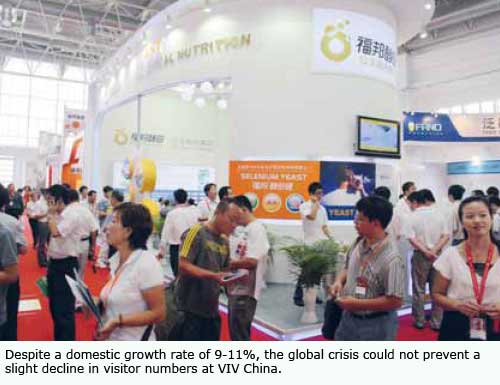The world takes a look in China – and the Chinese look back

Although not as well visited as hoped, VIV China, Beijing, 6-8 Sept 2010, was still a vibrant place, where a lot of international demand and supply met. A vibrant two-way curiosity could be noted. Where western companies try to find opportunities to build and expand strongholds in China, Chinese agricultural companies have definitely started sniffing abroad.
Only the sheer location of the show, the New China International Exhibition Center, exudes the total transition China is in at the moment. The venue, an enormous complex of which two vast halls were sufficient to house all of VIV China’s exhibitors, is located 30 kilometres out of the city centre – although no one gets the feeling Beijing is really left behind.
New takes over old at a dazzling pace in a country that is catching up with modern and western lifestyles. Population growth combined with a rapidly growing average income, is leading to a strongly increased demand for proteins. Added to this is the development of multi million-head cities that continue to attract thousands of people from the countryside; and a government that encourages the development of modern agricultural practices in an attempt to improve food safety. In a nutshell, this explains why China, especially for the international livestock industry, is the place to be.
At the moment, it is estimated that approximately 60% of total poultry in China comes from backyard production. In pigs, this percentage is even thought to be about 80%. As is more often the case, the more dynamic poultry industry took the lead in developing mass investment projects, but many international companies indicated that the investments in the pig industry are now really taking off as well. And since pork is the most important meat in China, the end is not in sight yet.
Long and winding
For foreign companies, investing in China can be a long and winding road – and perhaps nothing is as deceptive as jubilant trade perspective suggesting that any action will be rewarded tenfold with the pressing of one button. Making profit in China is possible, but requires a careful approach; hence many of the companies present in Beijing told similar stories. These are tales of frequent initial travel, establishing a permanent representation through agents or offices, and eventually even one or more production locations. These are also tales of slowly gaining confidence, the fear of being copied and initiatives to educate and transfer know-how.
Jansen Poultry Equipment, head-quartered in Barneveld, the Netherlands, was present in Beijing to promote its innovative poultry housing and feeding systems. The company occupied a booth within the Dutch pavilion at VIV China. For the company, it was the second time to be present at a big show like this in China. Recently, the company adopted a different mentality towards trading with China, Mari van Gruijthuijsen, general manager explained. “For a long time, we were thinking – if we come to China, our products will be copied. We got over this as we understand that customers are looking for solutions and systems rather than products.”Key to this change, Van Gruijthuijsen said, was the conviction that being copied would involve far more than just producing steel or plastic. “Our hardware may perhaps be copied, but the software cannot,” he adds. In other words, eventually, he believes quality and a systematic approach will prevail.
Steep learning curve
Poultry and pig equipment manufacturer Big Dutchman, head-quartered in Vechta, Germany, has already celebrated 15 years of physical presence in China, with the company just finishing the relocation of its Chinese sales team to Beijing. The company hopes to attract more internationally focused employees when being situated in the country’s capital. Meanwhile, the company’s development and logistics team remains located in Tianjin, 150 km south east of Beijing.
China definitely is a booming market, said Magnus Westerkamp, managing director of Big Dutchman Pig Equipment. The company’s growth in China has been well above the Big Dutchman average. Success did not just happen, Westerkamp said, speaking of a ‘steep learning curve’, when it came down to developing itself on the Chinese market. “One of the reasons for our success is hidden in the fact that we managed to adapt products to the Chinese market. For instance, we built a farrowing crate in the Chinese style – i.e. with a front gate – as we simply cannot sell just the European crates.”
Chinese companies
Just like many foreign companies being interested in investing in China, there are plenty of Chinese companies looking for opportunities to expand abroad. Knowing that labour is relatively affordable in China, once equipped with the right amount of knowledge, these companies can do serious business when exporting.
For Chinese companies, however, the outside world may be as much a challenge as it is for western companies to expand into China. Patent regulations, language differences, large conglomerates and cultural differences may offer difficulties for them.
Based in Qingdao, Shandong province, livestock manufacturer Big Herdsman started its business in 2002, after having been a business partner of Big Dutchman for some years. The company initially focused on poultry equipment, manufacturing and selling for example, feed lines and ventilation systems. About five years ago, the company went international with sales now extending to the rest of Asia and also the Middle East. According to Ami Shi, working at the company’s international department, sales in total have grown by 100% each year so far.
“We focus on innovative quality – we try to sell the best available in China,” Shi said. Two years ago, the company also started producing products for the swine market as well, like sow crates and feeding equipment, but so far these products have not yet gone abroad. “We will have to wait another two to three years until our product lines have matured,” she said. We have a good reputation and we would lose reputation if we cannot live up to the expectations.”
ZCME
A step further in its international development, is the Shanghai ZhengChang International Machinery and Engineering company (ZCME). The feed equipment company, which has been in existence since 1918, is said to have approximately 60% market share in constructing pellet mills in China for pig and poultry feed. The company started to look abroad as early as 1996 – and developed a very strong exporting business ever since, with operations running in South East Asia, the Middle East, North Africa and South America. As more companies have experienced, sales figures grew very rapidly and even now sales still double every two to three years.
At the moment, about 25% of ZCME’s projects are being conducted outside China, and it is likely that abroad is where the company’s growth is to be expected, said Hao Yun, board chairman. “What we see in China is that feed prices have been very low and this means that the smaller feed companies have the most limitations to survive in a competitive market. Their profit margins have been very low. What happens is that bigger companies, like New Hope or the Chia Tai Group (owned by Charoen Pokphand, ed.) buy this capacity – they buy these facilities instead of investing in new plants.”
“For this reason, we have chosen that we want to grow abroad with these big groups. CP Group, for instance, has started building a poultry feed plant in Bangladesh and they will use Chinese products and equipment for this, outside China.”











